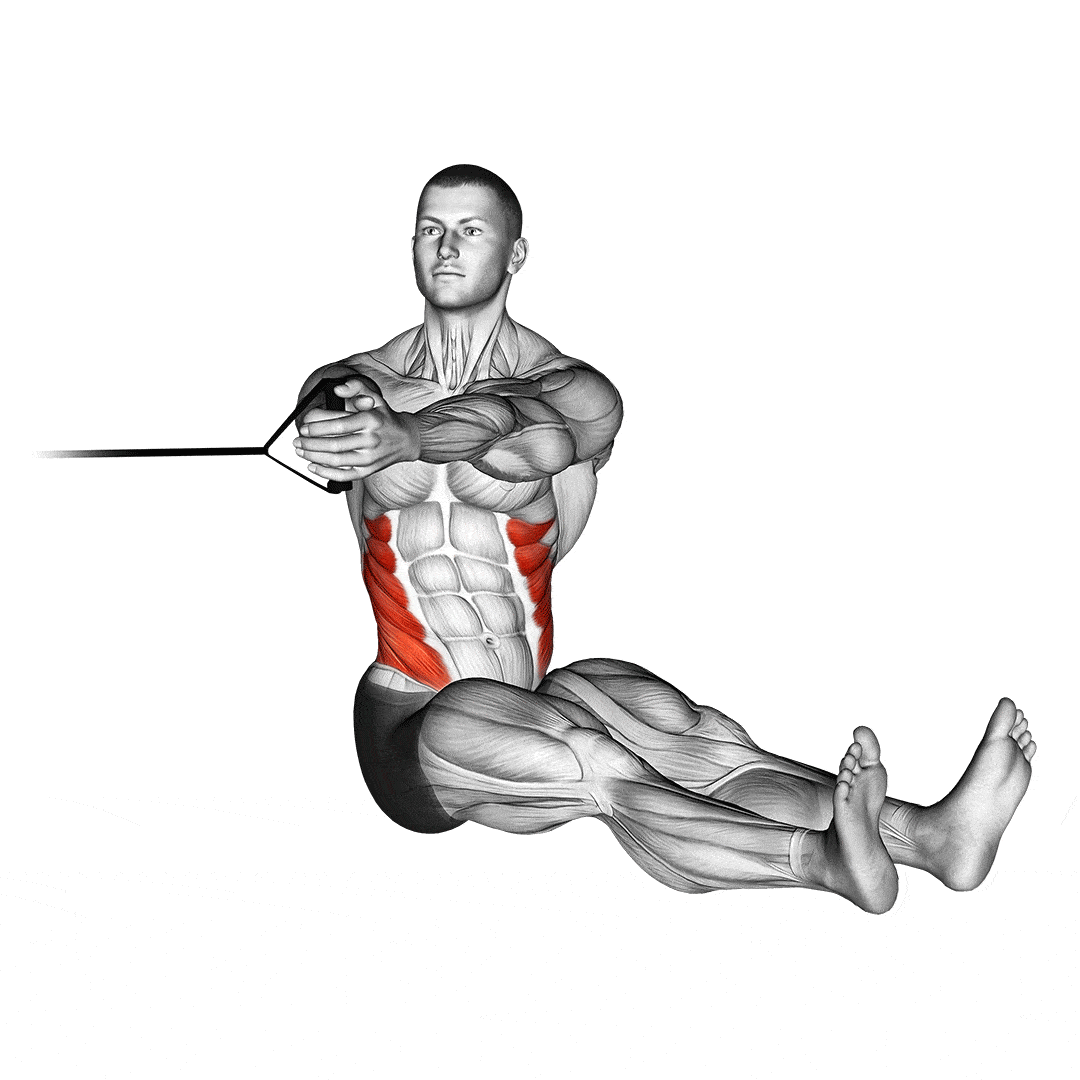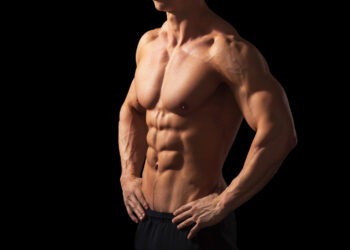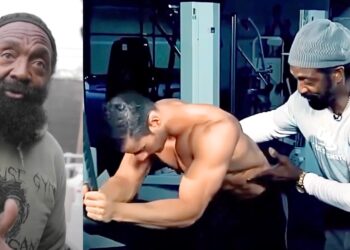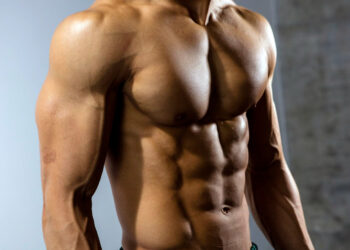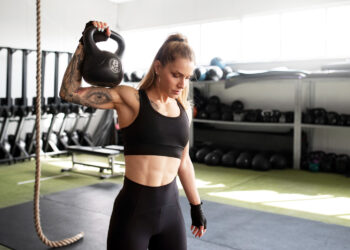To the newb, razor cut abs and obliques may be nothing more than a showpiece representing sexual appeal and desire with a little “I only train for myself and not anyone else” drizzled in. And that’s all fine and dandy if it motivates you to train. But if you’re an athlete, a daily active person, or are getting up there in age, you’ll appreciate what training the core will do for your performance, daily mobility, strength, and preventing muscle strains.
Today’s featured exercise, the band seated twist, a rotational-based core movement, is one of the simpler, home exercise-friendly techniques that you can use to strengthen the obliques with nothing but a standard-length elastic training tool, and an anchor point.
We’ll show you how to execute the band seated twist, tell you the benefits, warn you of common mistakes, and give you the best variations that you’ll love too!
Muscles Worked During Band Seated Twist
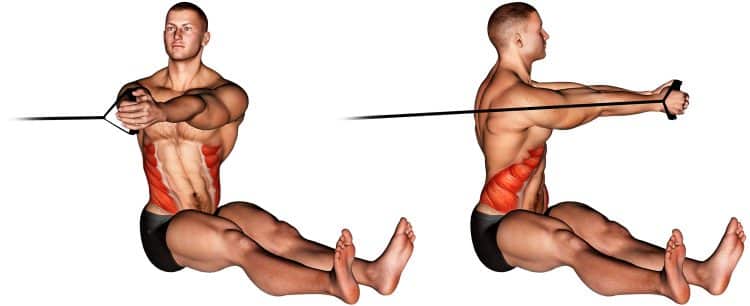
You should have one goal in mind with the band seated twist. To torch the oblique muscles that blend with your six pack abdominals to create the ideal-looking midsection.
Obliques
Core muscles on both corners of your torso that sandwich the six pack abdominals, your obliques appear like slabs of angled ribs, of which their function is directly correlated to the direction of their fibers. But there are two types of obliques, external and internal. The former slope inward toward the groin, while the internal fibers run perpendicular.
Level Up Your Fitness: Join our 💪 strong community in Fitness Volt Newsletter. Get daily inspiration, expert-backed workouts, nutrition tips, the latest in strength sports, and the support you need to reach your goals. Subscribe for free!
Twisting or bending sideways from the waist activates the oblique muscles, but the external obliques create movement via the opposite side, whereas your internal fibers facilitate motion on the same side.
How To Do The Band Seated Twist
Before you embark on an all out set of band seated twists, we recommend doing a few minutes of warmup activity to loosen up the obliques, get some blood to the area, and make the muscles more pliable to avoid pulls and strains when you use your working loads. This can be easily accomplished with some lying oblique crunches, and weightless twists.
Then you can commence the exercise via the following exercise steps, and complementary video demonstration below.
Steps
- Sit on the floor with your legs straight out in front of you and feet close to where you’ll anchor the resistance band.
- Secure your band to the anchor point roughly level with your upper belly.
- Move your legs to the right side of the anchor point and grab the band with your right hand.
- Sit up straight and engage the core muscles.
- Rotate your upper body to the right then simultaneously bend your right elbow, and pull the band toward the same side.
- Twist back toward the anchor point, extend your arm toward it then repeat steps 5 and 6 for the appropriate number of repetitions.
- When you’re finished on the right side, move your legs to the left of your anchor point, grab the band in your left hand and perform the movement for your left side.
You can see how it’s done by watching this short video tutorial.
Tips
- If you don’t have access to heavy training equipment like a power rack at a gym, you can anchor your band to a door attachment, park railing, a tree, or even a heavy and sturdy table leg. Or, you can get creative and find a different method to anchor your band.
- An exercise mat may offer added comfort and consequently, movement productivity, depending on the training surface.
- Any band can work for this exercise as long as it’s securely anchored, and you grip it from the same position when training both sides.
This Exercise
- Target muscle group: Obliques
- Type: Hypertrophy, strength
- Mechanics: Isolation
- Equipment: Resistance band and anchor point
- Difficulty: Beginner
Benefits of Band Seated Twist
Band seated twists offer benefits for the side portion of your torso including its appearance, and what it contributes to daily movement patterns, activities, and lifting habits.
Order a side of obliques…
If your abs are the main course, then you need a side of obliques to go with it. The two are designed to complement each other, and you should hence spend an equal amount of effort to develop both. But you have to incorporate rotation to maximize obliques, unlike the rectus abdominis which can be worked with heavy compound lifts such as squats, deadlifts, etc.
Enhance your rotational abilities
You’ll also see a brief mention of this later on under the standing oblique twist variation. But we’ll talk more about it right now, and that is the benefits of oblique training for physically active and competitive individuals whose abilities depend on the strength and function of their core muscles.
This includes essentially every type of athlete from the fighter to the baseball player, hooper, football jock, and you can see the pattern here. You cannot compete at a high level without strong rotational abilities.
Prevent muscle pulls and strains
Especially crucial for high performance athletes, more specifically, baseball players, and older populations, jumping into heavy rotational movements without a warmup, or abusing the obliques can spell bad news in the form of muscle pulls and strains in the side core muscles. After all, oblique strains oftentimes occur due to forceful twisting and bending motions.
Just look at this study on the prevalence of abdominal oblique muscle strains in baseball players, second only to hamstring injuries, with an increasing number of occurrences each year (1).
Band seated twists help not only strengthen but also stretch the muscles to, which could help keep them active and loose. Consequently, and possibly preventing risk of oblique injuries.
Common Mistakes During Band Seated Twist
While minor, you want to avoid these small mistakes that could cause a muscle strain or a lack of optimal oblique development.
Using too much resistance
It’s extremely common for beginners, and even ego lifters to perform exercises with, dare we say, poor form. Then when we learn proper technique which comes with training experience and learning, we realize we’re not as strong at a specific movement as we thought.
Then throw in training bands on top of it, and it oftentimes confuses the novice lifter due to the fact that you have to pay more attention to the setup when training with bands. First focus on your form, then worry about the resistance, and you’ll not only get better results but you’ll prevent injuries and strains.
Always high-rep sets
If you’re not interested in building your obliques, then go ahead and do a band seated twist rep marathon of endless reps. However, if you want to see some actual gains, keep your reps in the 8-25 range and choose a band that will challenge you to work hard especially in those last few repetitions.
Level Up Your Fitness: Join our 💪 strong community in Fitness Volt Newsletter. Get daily inspiration, expert-backed workouts, nutrition tips, the latest in strength sports, and the support you need to reach your goals. Subscribe for free!
Uneven training setup/band slack
You may need to change your foot position between sets to train your left and right sides optimally. Make sure that one side perfectly mirrors the other to prevent muscle and strength asymmetries. This also includes maintaining tension in the band, and not allowing any slack in it when your arm is stretched forward before the twisting motion.
This is where you’ll need to spend a little time setting up before you start the full training set. Otherwise you’ll waste energy and gains!
7 Variations and Alternatives of The Band Seated Twist
The band seated twist is just one way to train your obliques, and there’s its own advantages. However, exercisers also really like these similar variations and alternatives that’ll challenge you in a different way, and keep you excited to train your core muscles.
Standing cable twist
If you’ve read our other exercise guides, we always recommend standing exercise variations. Why? because you can learn how to engage your entire body during rotational activities. Look at boxers, MMA fighters, tennis players, and pretty much all sports athletes. They all require powerful, explosive rotation, and you can replicate this with a standing cable twist.
Low to high banded woodchoppers
What’s the difference between band woodchoppers and band seated twists? Woodchoppers mimic chopping wood, which involves angled, and up and down rotation, whereas seated or standing twists are a horizontal movement.
Nothing to anchor your band to for this variation? No problem. The following video demonstration will show you how to do them with using your feet as the base. However, keep in mind, while it will work the external obliques, rotating from low to high will really active the internal fibers.
We also recommend throwing in a high to low woodchopper using a band, or even better, cables.
Steps
- With your feet shoulder width apart, anchor the band down with just your left foot.
- Grab the band in your left hand then grip overtop with your right hand like shown in the below video tutorial.
- With your abs and butt tight, and arms fully extended down in front of your left side, twist your torso to the right while swinging your arms up overhead. You should feel the obliques contracting.
- Drop the arms back down while twisting back to the starting pose, then duplicate steps 3 and 4 for the desired number of reps.
Check out the movement in action shown via the following video clip.
High to low woodchoppers
Now for the external obliques that angle inward toward the groin, we recommend the high to low woodchopper. Attach your band to an anchor point overhead or as we mentioned before, cables are truly the king of this technique. But either will do just fine depending on which one you have available. But just as important is the amount of resistance used.
Learn more about woodchoppers here.
Side plank bridge twist
You don’t need a band and you won’t want it after you see how good of a bodyweight only oblique exercise this is. Performed from a side plank position with your body resting its weight on the forearms and supported by the legs, you’ll need to maintain a neutral body while you twist in and out.
Tips
- Make sure to get full rotation by reaching through and under your body.
- Focus your mind on using your obliques to performing the twisting motion.
- As you rotate out into a side plank pose you can do a side crunch motion to further stimulate the obliques.
Russian twists
A band seated twist in its own right, the Russian twist can be a bodyweight exercise or you can add resistance by holding a medicine ball, dumbbell or anything you can safely lift from side to side using your arms. And the fact you’re sitting on your butt at an angled position pre-engages the core, while the twist activates the obliques.
Related: The Best Russian Twist Alternatives For a Rock-Hard Core
Broomstick twist
The pose screams old-fashioned but its effectiveness cannot be denied. Even recommended by top trainer and exercise professional Jeff Cavalier, MS PT CSCS, of Athlean X YouTube channel, you need to be doing these!
For written instructions on broomstick twists, check out this article on the 5 ‘Old School’ ab exercises you should be doing. Or you can fast forward to the 3:44 timestamp in the video below for a demonstration of broomstick twists. Note: The provided video tutorial is also included in the aformentioned article.
Exercise ball weighted twist
Your obliques, and as a matter of fact, your entire core will have no choice but to join in on this workout ball weighted twist. With the ball rolling, and it’s bouncy material, there are additional elements that make this exercise pretty challenging, especially while holding a weighted object. But you could start with just your body weight first, which may be wise if you’re a beginner, and typically don’t train for balance and stability.
Here’s a nice and slow demonstration of the exercise ball oblique twist.
FAQs
What's the appropriate band strength for seated oblique twists?
Both the band strength and your body’s distance from the anchor point will determine how much resistance is used during the exercise. The closer you are to the base, the easier your set will be and vice versa.
Choosing the right band/s is not always easy especially for beginner exercisers who are not yet aware of their capabilities. Therefore, we recommend getting a band set with a few different band options.
You’ll need a combination of both the right band, and proper body position that creates a moderately challenging exercise when performing the exercise using a full, comfortable range of motion.
How many sets and reps should I do for band seated twists?
The average exerciser should aim for 2-3 sets x 8-25 reps per workout. Varying the intensity between workouts, and hence the amount of resistance, and number of repetitions.
Don’t go too light, but don’t load band seated twists too heavy either. Challenge yourself and strive to build oblique strength by implementing progressive overload via a combination of more resistance, and repetitions.
How many days per week should I do the band seated twist?
So many factors determine appropriate training frequency. But it more so depends on your overall training regime, and goals.
Someone more serious about their core training may get better results from training the obliques at least two to three times per week while a novice lifter should train their midsection at least twice per week.
Can I use the band seated twist solely for my oblique training?
You certainly could. However, you may get bored, and using just one technique isn’t typically the best way to maximize your gains, especially since there are two obliques (Internal and external) that may benefit most from using two different training angles.
Wrapping Up
Change up your boring old oblique side crunch oblique workouts with a sitting twist using resistance from a training band. Sure, the one drawback is that you need something to anchor it to, especially if you train at home, but using the tips above should make it easy to add a new exciting core exercise to your midriff regime.
Good for both the internal and external oblique muscle fibers, the horizontal movement of band seated twists makes it a versatile exercise. But you’ll need to choose the appropriate band strength, and move your body with enough rotation for the best gains.
Everyone from athletes who perform powerful rotation in their respective sport to the average lifter, or elderly who want to strengthen their core will benefit from this home exercise friendly core technique.
Reference:
- Komatsu S, Kaneko H, Nagashima M. Characteristics of internal oblique muscle strain in professional baseball players: a case series. BMC Sports Sci Med Rehabil. 2022 Jun 25;14(1):118. doi: 10.1186/s13102-022-00510-5. PMID: 35752868; PMCID: PMC9233777.
Interested in measuring your progress? Check out our strength standards for Deadlift, Side Crunch, Squat, and more.

